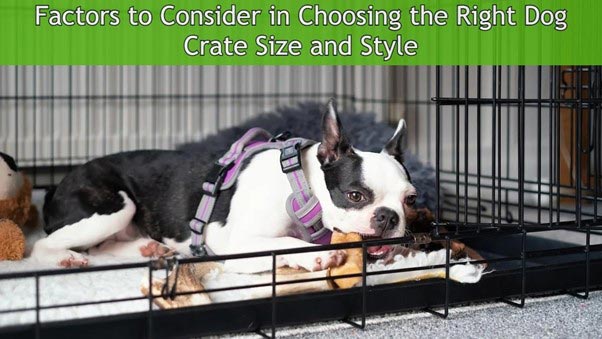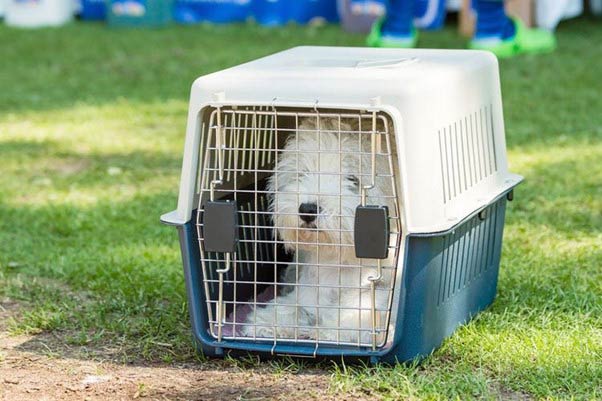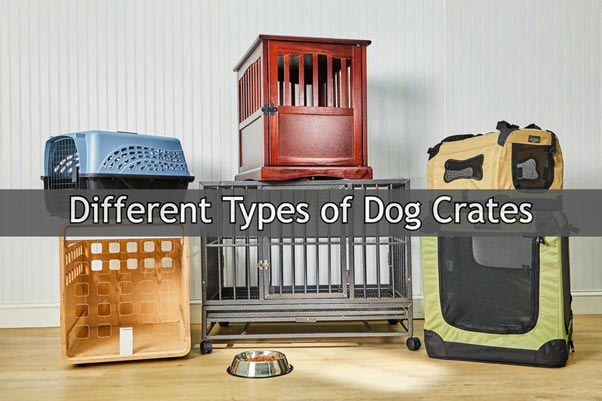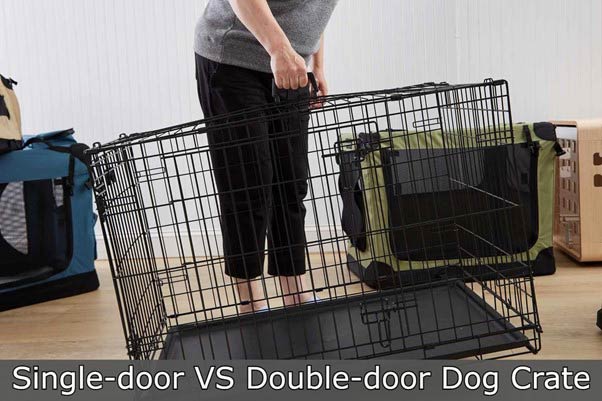
How to Choose the Right Dog Crate Size and Style
Choosing the right dog crate size and style is an important decision when it comes to providing your pet with a safe and comfortable home.
The size of the crate needs to be appropriate for your dog’s breed, age, temperament, and energy level.
There are different types of crates available that suit various purposes and provide different levels of security and comfort.
Before making a purchase, it’s important to do your research and decide which type best suits your needs.
Things To Consider When Choosing A Dog Crate Size
When selecting a crate for your pet, several factors must be taken into consideration. Some of the factors are as follows:
Measure Your Dog's Height and Length
Before selecting a size, measure your dog’s height and length from nose to tail. Most crates come with height measurements, so make sure you select one that fits your pup’s dimensions.
Consider The Weight and Age Of Your Dog
If you have an older or larger dog, they may need more space in their crate as they grow and develop.
On the other hand, puppies usually require smaller crates to give them enough room to move around without being too cramped.
Think About Their Activity Level
If your pup is a high-energy pooch who loves to run and play, then you should opt for a bigger crate so they can have enough room for all of their activities.
On the flip side, if you have an elderly or low-energy pup who likes to take naps throughout the day, then a smaller crate will be sufficient for them.
Make Sure You Have Enough Room In Your Home For The Crate
If you’re limited on space in your home or don’t want to take up too much space with the crate, opt for one that is more compact and fits in with the rest of your furniture décor nicely!
Also, keep in mind how easily you can move it around – some crates are heavier than others so make sure it’s not too difficult for you to transport it when needed.
Check The Material Of The Crate
Different materials provide different levels of comfort and durability for your pup – make sure that whatever material you choose offers breathability as well as protection from outside elements (like wind).
Additionally, think about whether or not the material is easy to clean – this will save time during cleaning sessions!

Check For Proper Ventilation
Good ventilation helps keep your pup cool on hot days – look for crates with mesh windows or vents that provide ample airflow without compromising security or privacy inside the cage.
This will help ensure that your pup stays comfortable even during extended periods inside his/her new home away from home!
Ensure There Is Enough Space To Move Around Comfortably
No matter which size crate you choose, make sure there is enough room inside so that your puppy can turn around comfortably while still having plenty of space left over for toys and treats!
A good rule of thumb is at least two times their body length plus two times their shoulder width should give them ample movement room inside the cage without feeling cramped up at all times!
Pay Attention To Features That Make Cleaning Easier
Some crates come with removable trays underneath which makes cleaning much easier – no more having to bend down and reach into tight spaces to get rid of messes!
Also, check out features like washable bedding (if applicable) which can be quickly removed and thrown in the washing machine for easy upkeep in between deep cleanses!
Look For Easy-To-Use Locking Mechanisms
When considering which type of lock mechanism works best for both you and your pup – look out for ones with easily accessible latches and locks so that putting them together won’t be an issue regardless of age or mobility level
Additionally, make sure it has secure locking mechanisms so that pups won’t be able to wiggle their way out when unsupervised; this will help keep them safe while giving them peace of mind knowing they won’t escape unexpectedly!
Don't Forget About Accessories and Extras
Last but not least don’t forget about accessories such as soft mats which add extra cushioning on bottom surfaces as well as cozy blankets which provide warmth during colder months.
These items can help create a welcoming environment inside the cage while also providing additional comfort levels depending on what type of climate they live in (i.e., cold vs hot climates)!
Accessories also come in handy when traveling since most airline carriers allow certain sizes depending on where one flies out to!
Types Of Dog Crates
There are a variety of different types of dog crates available on the market, each with its advantages and disadvantages.
Soft-Sided Dog Crates
Soft-sided dog crates are made out of fabric and mesh and they provide a lightweight option for pet owners who travel frequently with their furry friends.
Another advantage of soft-sided dog crates is that they are easy to store away when not in use. However, keep in mind that these types of crates do not offer as much security as some other types of dog crates.
Also, if your pup is particularly active or aggressive, then a soft-sided crate likely won’t hold up very well.
Plastic Dog Crates
If you have an easily excitable pooch who likes to chew, then plastic dog crates might be the perfect choice for them.
These types of crates provide a secure environment for your pup while also being durable enough to withstand all their destructive impulses!

The only downside to plastic crates is that they can be quite bulky and awkward to move around—but if security is what you’re after, this could be the ideal choice for your canine companion!
Wire Dog Crates
Wire dog crates are considered one of the most versatile options because they come with several features such as adjustable panels and removable dividers, allowing pet owners to customize them according to their own needs.
Furthermore, these types of cages also provide excellent ventilation due to their wire construction —perfect for those hot summer days!
One major downside though is that wire cages are not suitable for destructive dogs since they can easily bend or break the wire bars with their teeth or claws. If your Fido is a power chewer then you will likely need a steel crate. Check out this list of recommended heavy-duty crate for chewers.
Wooden Dog Crates
As far as aesthetic appeal goes, wooden dog crates take it up a notch—plus they blend in nicely with any existing furniture in your home! Wooden cages also offer excellent insulation from both cold weather and extreme temperatures.
However, one disadvantage is that wooden cages tend to be quite expensive compared to other types of dog cages —so make sure you factor this into your budget before making a final decision!
Frequently Asked Questions About Crate Sizing And Style
As far as aesthetic appeal goes, wooden dog crates take it up a notch—plus they blend in nicely with any existing furniture in your home! Wooden cages also offer excellent insulation from both cold weather and extreme temperatures.
However, one disadvantage is that wooden cages tend to be quite expensive compared to other types of dog cages —so make sure you factor this into your budget before making a final decision!
Question: What size crate should I buy for my dog?
Answer: The size of the crate you buy should be appropriate for your dog’s breed, age, temperament, and energy level.
Generally speaking, the crate should be tall enough so that your dog can stand upright without bumping their head and wide enough to move around comfortably.
The floor area of the crate should also provide enough space for your dog to lie down and turn around easily.
Question: What type of dog crates are best?
Answer: The type of dog crate that is best for your pup depends on their individual needs and lifestyle. Wire crates are lightweight, strong, durable, and easy to clean.
Soft-sided crates are portable and come in a variety of sizes, making them ideal for travel or short stays away from home.
Plastic crates are also lightweight and easy to clean, but they don’t provide good ventilation. Heavy-duty metal crates are strong and secure, making them ideal for larger dogs or aggressive breeds.

Question: Are dog crates safe?
Answer: Yes, when used properly, dog crates are a safe and secure way to contain your pup. Ensure that the door on the crate is secure and cannot be opened by your dog or other animals. Additionally, look for a crate that is constructed from durable materials and has plenty of ventilation.
Question: Is there a difference between wire crates and plastic crates?
Answer: Yes, there is a big difference between wire crates and plastic crates when it comes to sizing and style. Wire crates are typically more customizable since they come in several different sizes and styles that can accommodate most breeds.
Plastic crates on the other hand typically come in one or two standard sizes which may not fit all breeds. Additionally, wire crates tend to have more airflow than plastic crates which can make them more comfortable during hot summer months.
Question: Is there an ideal crate size for puppies?
Answer: When it comes to puppies, it is important to choose the right-sized crate that will allow them to grow into their full-sized adult selves without being cramped or uncomfortable in their space.
For young puppies, you will want a smaller-sized crate with adjustable panels that you can add as they grow bigger over time. You will also want to double-check the measurements of the crate against your puppy’s breed standard so that your pup has adequate room as they mature.
Question: Are there any special considerations I need to make when selecting a crate style?
Answer: When selecting a particular style of crate for your pet, you will want to consider several factors such as safety, convenience, ventilation, visibility, ease of assembly/disassembly, security features (locks), portability (collapsible designs), durability, affordability among others.
Depending on your individual needs or preferences some styles might be better suited than others for your pet’s health and happiness!
Question: How many doors should my crate have?
Answer: Most basic wire crates usually come with two doors – one on the front side and one on top – but some may have even more depending on their design or purpose (such as airline-approved models).
Having multiple access points can be convenient if you plan on using the crate not only at home but also while traveling or taking trips outside of your living space with your pet!
Question: Is there an advantage between purchasing a single-door versus a double-door model?
Answer: When considering whether or not you need a single-door versus double-door model depends largely on how much access you would like when entering/exiting the kennel with your pet and where exactly you plan on placing other furniture in the house (inside or outside).

Double-door models offer extra flexibility since both doors open completely allowing better maneuverability within tight spaces whereas single-door models only have one way in/out making them better suited for open areas such as garages or patios where larger openings aren’t needed necessarily due to limited space restrictions inside of rooms/homes!
Question: Does color matter when picking out a new cage?
Answer: When choosing a new cage color isn’t typically something most people think about however certain colors may help improve visibility from afar making them easier to spot if lost during travel or playtime outdoors!
Additionally, some pets may have color preferences when it comes down to aesthetic appeal which could sway them towards certain tones over others depending on how active they are around their environment since brighter shades tend to show dirt much faster than darker hues do!
Question: What material is best for small dogs?
Answer: Smaller breeds require lighter-weight materials such as aluminum alloy frames which are lightweight yet strong enough to handle smaller amounts of stress put by their owner’s day-to-day activities such as playing fetch or running around indoors/outdoors without compromising safety standards!
Additionally, plastic trays with rubberized edges help protect against minor scratches caused by sharp claws while keeping noise levels low during movement inside of cages too!
Question: Should I get a collapsible cage for my dog?
Answer: Collapsible cages are great options when needing something portable since they can be taken apart easily into two halves and then folded up completely into flat pieces.
This makes storage an effortless task when not needed at home anymore due to lifestyle changes like potential moves across town/state limits etc.
Just make sure whatever material is used, offers adequate structural support when fully assembled before loading onto vehicles and heading off towards unknown destinations ahead!
Question: Do I need accessories with my new cage purchase?
Answer: Though accessories aren’t necessary additions most people find value in having items such as bedding sets, feeding dishes placemats, etc.
It comes in handy during use, helping create personal environments tailored especially according to specific lifestyles encouraging bonding times between animals, and owners, and making life much more enjoyable overall near and far away from home!
Conclusion
With so many different types available on the market today, finding the right type of cage for your pup can seem like an overwhelming task – but don’t worry!
By understanding which type works best for their individual needs (i.e., size requirements, budget constraints), pet owners can make an informed decision about which type of cage would work best for their furry family member.
Hopefully, this comprehensive guide has helped shed some light on the different kinds available so that you can find a solution that works best for you and your four-legged friends alike! Happy crate shopping!
Learn more by clicking the link below.